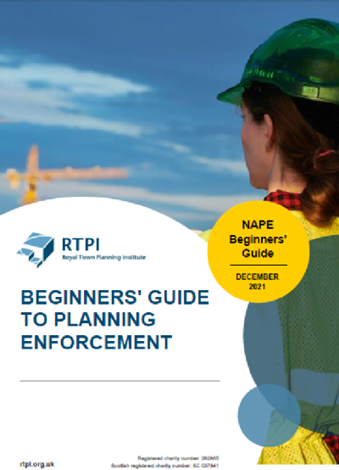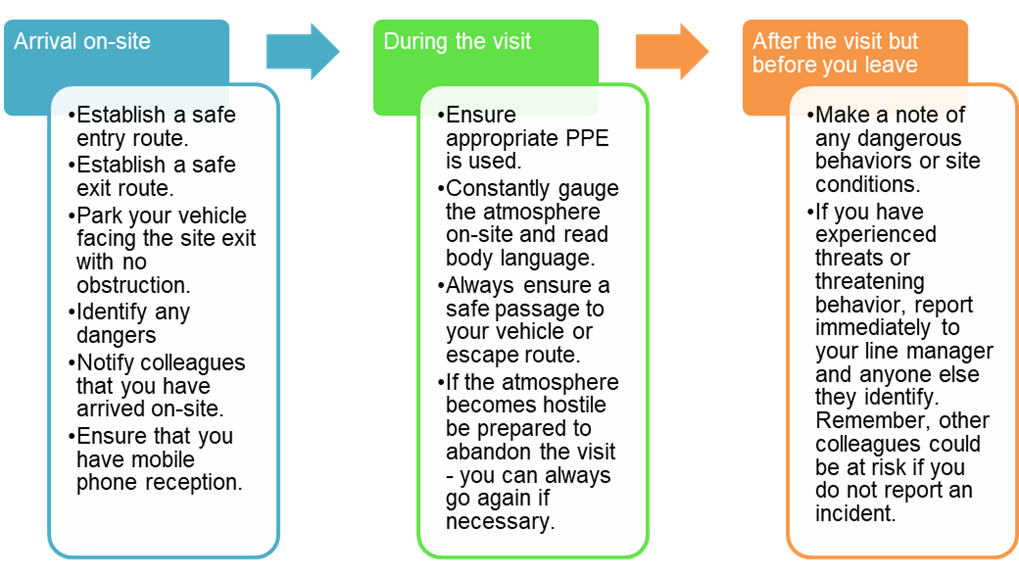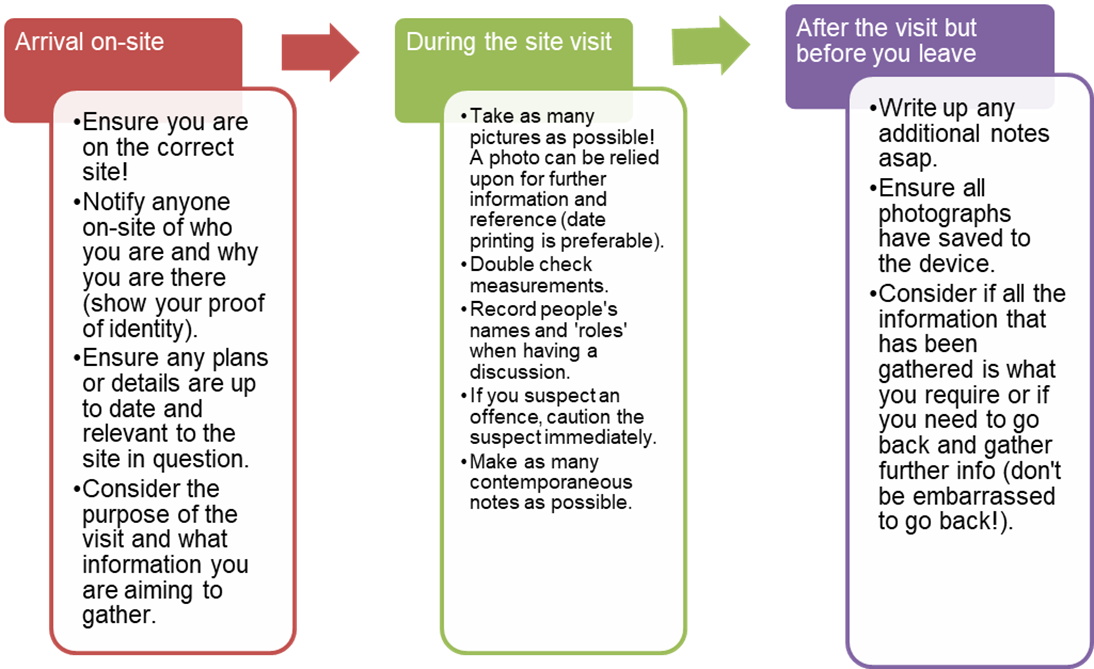 Acknowledgements
Acknowledgements
This first (December 2021) edition of the Guide was funded by the Department for Levelling Up, Housing and Communities.
The National Association of Planning Enforcement (NAPE) Management Committee would like to thank all those who have contributed to this Guide, and the RTPI for its continued support of NAPE.
This Guide will continue to be reviewed and updated by NAPE Management Committee.
You can download the guide here or read in full below
Contents
1. Starting points as an Enforcement Officer
2. Before going on-site
3. When on-site
4. Dealing with conflict on-site
5. Post site inspection
6. Looking at initial evidence
Sources of information
Appendix: Pre-Site Inspection Checklist
Introduction
(Neill Whittaker, Ivy Legal)
The backbone of the Planning System is Planning Enforcement. Equally as important as the plan makers and the development mangers, Planning Enforcement is there to ultimately preserve the integrity of, and public confidence in, the planning system by ensuring that development accords with the rules. Without it our environment, both built and natural, suffers.
This guide is squarely aimed at those who are new to Planning Enforcement who may be starting a new job as an Enforcement Officer within a Local Planning Authority (LPA), with no previous experience of investigating an alleged breach of planning control. Being an Enforcement Officer is a tough but rewarding job. You are the boots on the ground, and the eyes and ears of the planning system.
The skills and knowledge you will need to develop as an Enforcement Officer are wide ranging and will inform how important decisions are made. Whether you are required to explain to a member of the public why their neighbour’s extension is permitted development, or to decide why it is expedient to take enforcement action in relation to a breach of planning control, each decision made will be due to your thorough and diligent investigations.
This guide is a starting reference point on how to undertake those investigations.
1. Starting points as an Enforcement Officer
(Craig Meikle, The City of Edinburgh Council)
Top tips
- Negotiate, remediate, enforce in that order
- Shadow colleagues
Planning Enforcement is discretionary. It is not compulsory for a LPA to act against a breach of planning control. This concept can be confusing to new officers entering the profession for the first time. The term “Planning Enforcement” can imply a hard-line approach against all unauthorised works and occasional articles in the media about LPAs carrying out demolitions accentuates this perception. However, the role of a Planning Enforcement officer is not to punish individuals, but rather to remedy problems caused by unauthorised works.
With any breach of planning control, a Planning Enforcement Officer must consider if action would be expedient. In other words, is the level of harm so significant that it warrants formal action, or do the works generally comply with policies and guidance? This is often referred to as the “public interest test”. Where there is significant harm and it is in the public interest to do so, then enforcement action should be taken without undue delay. Alternatively, if the breach of planning control raises no planning issues, then as an officer, you are supported both by national and local government not to take further action.
A further fundamental principle of Planning Enforcement is proportionality. In many instances, it may be more appropriate to negotiate a resolution with a party rather than pursue formal actions. Beyond informal negotiations, the powers which are available to LPAs can be quite daunting at first glance, especially when set out in legislative documents. However, as a starting point, new officers can refer to LPA enforcement plans or charters. These can provide useful information in terms of getting a grounding of the LPA priorities as well as the legislative powers you have at your disposal.
Site inspections are a valuable tool for gathering evidence about a breach. When you first start your career, speak to your colleagues, and learn from their experiences. An important part of any career in Planning Enforcement is the shadowing of colleagues. If this isn’t offered when you first enter a LPA, then ask for this opportunity. This is by far the most effective learning tool when entering the profession and will give you confidence when having to eventually conduct site inspections on your own.
Finally, be confident and positive about your future career in Planning Enforcement. Planning Enforcement sits alongside plan making and development management as a vital third pillar which upholds the integrity of the planning system. Being a Planning Enforcement Officer will provide you with an invaluable grounding in planning legislation as well as many other invaluable transferable skills for working in a LPA.
2. Before going on-site
(Dawn Russell, South Gloucestershire Council)
Top tips
- Understand the case you are investigating
- Be fully prepared before going on-site
As stated in the previous section, site inspections are invaluable for gathering evidence. Before attending site to investigate a breach of planning control, Planning Enforcement Officers must:
- have a good initial understanding ‘in planning terms’ of the matter they are investigating;
- ensure that they are equipped with what they will need to carry out that investigation; and
- ensure that they will be safe whilst carrying out their duties.
The Appendix to this guide contains useful checklists to help prepare you for every site inspection.
Officers should be trained by their LPA prior to attending site to keep them safe and enable them to confidently and effectively carry out their duties. The NAPE Planning Enforcement Handbook and annual Planning Enforcement Conference will provide you with valuable information and advice in relation to relevant matters and legislation. In addition, Planning Enforcement Officers should be equipped for:
- Conflict resolution and dealing with aggressive parties
- Interpreting body language
- Development of good communication skills
- Managing meetings
- Overt/covert surveillance (refer Section 1.3 of the NAPE Planning Enforcement Handbook)
3. When on-site
(Richard Marshall, Newark and Sherwood District Council)
Top tips
- Safety comes first
- Remain professional and in control
- Record as much evidence as possible
The starting point for undertaking a site inspection or meeting is to be aware that as an officer of a LPA, you are authorised by legislation to enter land to determine whether there has been a breach of planning control and to determine how any powers conferred on your Authority should be used.
For further details about your rights of entry as an Enforcement Officer, both with and without a warrant, see Section 2.2 of the NAPE Planning Enforcement Handbook.
When going on-site, whether for an unannounced inspection or a pre-arranged meeting, it is imperative to remember that although you are employed to carry out the duties prescribed by your employer, ultimately your safety and the safety of other members of the public are paramount. Often an inspection will take place with people who do not want the officer to be there. As an officer you should therefore be aware of possible hostilities and techniques to either minimise risk or to extract yourself if necessary (refer to Section 4 of this guide for further information about minimising the potential for on-site conflict).
Whilst on-site your behaviour and actions should always remain professional. Behaviour management is key. You should try to remain in control of the visit (including keeping discussions ‘on topic’). It is sometimes necessary to show empathy to a person to then turn the conversation back to the reason for the inspection or meeting – and ultimately gather the necessary information.
There are two key areas to consider whilst on-site:
Site safety

Gathering information

4. Dealing with conflict on-site
(Tom Wicks, Enforcement Services)
Top tips
- Conflict assists no-one
- Remain calm, and clear as to your purpose
Whether between Enforcement Officer and developer, complainant and agent, councillor and constituent, or any combination thereof, verbal or physical conflict on-site rarely furthers the aims of planning enforcement. On most occasions it only delays or prevents positive planning outcomes. It is not the job of a Planning Enforcement Officer to encourage, resolve, or put up with conflict on-site, and it should be avoided where possible.
Having a clear understanding of the purpose of a site inspection is key to avoiding and dealing with conflict on-site. Whether it’s the first site inspection following a complaint or some years later to check compliance with an enforcement notice, the purpose of a site inspection is to observe and share information. It is not to persuade a developer to undo development or win an argument about the limitations of permitted development.
Key measures you can take to minimise the potential for on-site hostilities include:
1. Prepare well
Complete the checklist set out in the Appendix, and ensure you have the names of owners and/or occupiers
2. Only take who is necessary
To avoid intimidating people
3. Allow plenty of time
To avoid rushing and offending people
4. Take evidence of your powers of entry
Have ID on display
5. Introduce yourself and explain your purpose before you start.
Hearing a name and friendly greeting can disarm people, whereas looking around and taking photographs before introducing yourself can upset people.
6. Be honest and open about the purpose of your visit
Explain that you are there to see what’s there, take photographs, and report back to the LPA.
7. If someone is obstructive
Explain your powers under the relevant legislation and that if you are obstructed you may have to return with the police, with or without notice.
If you continue to be obstructed, leave. However, if possible, establish the nature of the obstructive person’s objection, clarify their identity and authority, and explain the consequences of a visit without their consent. Establish the terms of future visits and arrange an appointment.
8. Remember your safety comes first
There is no planning enforcement problem that is worth risking your safety or that won’t wait until tomorrow.
9. Record everything
As soon as possible after the visit – write up notes, download photographs, draft letters and inform supervisors of any obstruction / conflict, as per the advice set out in Section 3 of this guide.
10. Maintain a record
Include persons, places and times when safety has been threatened and engage with others to learn from experience.
5. Post site inspection
(Chris Blair, Ards and North Down Borough Council)
Top tips
- Ensure you can exit the site safely
- Stay in contact with your office
- Record, sign & date all evidence gathered
As discussed earlier in this guide (see section 2), preparation is key before heading out on-site. However, it is important to remember that post site checks are just as invaluable as pre-site inspection preparations.
It is important to remember that a Planning Enforcement Officer’s role is to investigate alleged breaches of planning control. Whilst most cases will likely be due to ignorance of legislation, there will be occasions when unauthorised development has been carried out deliberately, without due regard to the regulations or the surrounding environment.
As such, it is important to get into the habit of always carrying out the following steps after concluding either individual or multiple site inspections (although it is acknowledged that each LPA might have its own specific way of completing post site checks):
Leaving the Site
- Parking your vehicle facing the exit with no obstruction (as recommended in Section 3 of this guide) will better enable you to remove yourself from the site expeditiously following your site inspection.
- Make sure you have everything with you that you brought onto the site when you leave, particularly your warrant card, phone and camera (for assistance see the checklists set out in the Appendix).
- Make sure you phone/text/message your line manager, colleague, or office generally to confirm that you have safely left a site. There may be occasions when an inspection requires two officers to attend. Ensure you agree who will contact the office after the completion of a visit. Do not just assume that the other person will do it.
- Notify your office once all your planned site inspections are completed.
- If you decide to inspect a site that is not on your planned list, contact your manager/the office generally to advise them of this. Please ensure you inform them of the approximate time of the visit and confirm completion afterwards.
- If, following a site visit, you have concerns that you are being followed, either drive straight to a local police station or park your vehicle (if safe to do so) and call the Police.
- Following on from point 6, update your manager of these issues as soon as you can. Your safety during site visits is of paramount importance.
Information gathered on-site
- Once you have safely left the site, complete a detailed site note of your visit. This should include:
- the name and contact details of anyone you spoke to on-site;
- the details of any discussions that have taken place on-site;
- the ongoing use/development you have observed on the site;
- any construction work you observed being carried out on-site;
- details of any measurements you have taken on-site;
- details of the surrounding area including other buildings etc.; and
- any observations regarding alleged breaches of planning control.
It is not always possible to note this information down when you are on-site. You should, however, try to do this as soon as you are safely able to, while the information is fresh in your mind.
- Sign and Date the site note and attach it to the Enforcement case file.
Saving and Documenting Information at the Office
You should ensure that you carry out the following either back at the office or, if you are able to, when working from home:
- Input your site inspection date into the computer system.
- Transfer and Save photographs taken on-site onto your computer system.
- Print out the photographs, sign/initial and date them then attach to the enforcement case file. Each photograph taken should be signed and dated accordingly. Do not just sign on the border next to one photograph. These may be needed for evidence at future hearings/court proceedings, so it is essential to sign & date each photo.
- If you have collected other data during the site inspection, such as Spot Levels, Building Measurements etc., ensure that these are appropriately saved on the computer system and a copy printed off and attached to the enforcement case file.
- Input the names (and addresses if obtained) of the owner/operator of the site into your computer system.
6. Looking at initial evidence
(Craig Allison, Hambleton District Council and Liam Jones, Swansea Council)
Top tips
- Conduct an appraisal
- Ask yourself the right questions
Following a site visit, you will need to collate all available evidence as part of the enforcement investigation in accordance with Section 5 above.
With this stored information, you will need to look back through all the evidence gathered before and after your site visit and decide what will be done next.
Conduct an Appraisal
It is suggested that you undertake an appraisal of the following:
- Any previous or current planning (or related) applications (refusals or approvals) and appeals relating to the site.
- Any previous or current pre-application enquires relating to the site.
- Any previous or current Building Regulations applications relating to the site.
- Previous enforcement records.
Key Questions
Following on from an appraisal, the following questions will help you decide what your next stage will be in the investigation:
- Do the works constitute development? (Refer to Section 3.1 of the Enforcement Handbook) If No close case. If Yes: go to 2. below.
- If the works constitute development are the works Permitted Development? (Refer to Section 3.2 of the Enforcement Handbook for details on permitted development. If Yes close case. If No: go to 3. Below.
- If the works constitute development and are not considered to be permitted development, you need to consider if the development is so severe that it would warrant the LPA to serve a Temporary Stop Notice (TSN) or Full Stop Notice (with enforcement notice). (Refer to Section 6.3 and 6.4 of the Enforcement Handbook).
- If the breach of planning control does not warrant the serving of a TSN or Full Stop Notice. Are the works likely to be acceptable and is a planning application appropriate to remedy the breach? If Yes: write to the owner of the land to request a planning application. If No pursue formal enforcement action.
Pursuing Enforcement Action
Where the works require planning permission and permission will not likely be forthcoming for the development you will need to undertake steps to remedy the breach of planning control.
- In the first instance, a Planning Contravention Notice and/or Requisition for Information could be necessary (Refer to Section 1.2 of the Enforcement Handbook).
- Undertake a Land Registry search.
- Obtain approval to issue notice, draft and issue. Refer to your local enforcement plan (if applicable) for further details on who has authority to issue a notice.
7. Sources of information
(Craig Allison, Hambleton District Council)
There are several helpful sources to review whether there has been a breach of planning control or if you are just looking for some further commentary and guidance. Below is a list of links to valuable information:
- The RTPI NAPE Planning Enforcement Handbook gives an understanding of all the relevant powers available - https://www.rtpi.org.uk/practice/2020/may/planning-enforcement-handbook-for-england/
- Town and Country Planning Act 1990 is a good starting point to establish the law around planning - https://www.legislation.gov.uk/ukpga/1990/8/contents
- National Planning Policy Framework, Paragraph 59 details the importance of enforcement plans in the planning system - https://www.gov.uk/government/publications/national-planning-policy-framework--2
- Planning Portal Interactive House provides assistance on householder development - https://www.planningportal.co.uk/info/200125/do_you_need_permission/90/interactive_house
- Planning Portal Change of Use Permitted Changes, provides useful guidance on all the changes of use that can occur without the need for planning permission - https://www.planningportal.co.uk/info/200130/common_projects/9/change_of_use/2
- Town and Country Planning (General Permitted Development) Order 2015, legislation sets out all permitted development rights -https://www.legislation.gov.uk/uksi/2015/596/contents/made
- Town and Country Planning (Control of Advertisements) Regulations 2007, details the types of adverts that can be displayed without the need of advertisement consent - https://www.gov.uk/guidance/advertisements
- Section 215 provides best practice guidance on untidy properties - https://www.gov.uk/government/publications/town-and-country-planning-act-1990-section-215-best-practice-guidance
- Google Earth or Street view can help you to establish how the site has changed over time. This is a useful tool to establish if anything is immune from enforcement action, by virtue of it being more than four or ten years.
- Within your LPA there should be a Local Enforcement Plan, to which you should review and understand how your Authority deals with planning enforcement investigations.
- You should also read your LPA’s Local Plan to understand what type of development is acceptable in certain areas.
Conclusion
(Neill Whittaker, Ivy Legal)
We hope that this guide has improved your understanding of the basics of Planning Enforcement.
Whilst the majority of enforcement investigations lead to an amicable solution, some will lead to formal enforcement action. If that does not remedy the breach, potential court or direct action may follow. The information gathered at an early stage of an enforcement investigation can have a great bearing on the outcome of formal action, particularly if an enforcement notice is appealed. Therefore, it is very important that Enforcement Officers develop the skills and knowledge of what is required to carry out an enforcement investigation, to ensure that sound and informed decisions are made in the first instance and that those decisions can be robustly defended at a later stage in the process.
For more in-depth information on Planning Enforcement, NAPE has produced the Planning Enforcement Handbook; a copy of which can be found here. The handbook goes into greater detail about the powers available to Local Planning Authorities. For more information about NAPE and the benefits of becoming a member please visit the relevant section of the RTPI website.
Appendix: Pre-Site Inspection Checklist
(Dawn Russell, South Gloucestershire Council)
|
Be Prepared |
 |
|
|
Understand the Complaint |
Read the detail of the concern from the complainant. Identify all matters. Have a full understanding of each matter raised. |
|
|
Site Location & Enforcement History
|
Identify the site location & check the planning enforcement history. Has this matter been investigated before? Do any previous investigations provide useful information for your current investigation? |
|
|
Planning Permissions |
Check any previous planning permissions granted for the site. Is planning permission unconditionally or conditionally granted for the matters raised. It may be necessary to check compliance against a planning permission whilst on-site. |
|
|
Historic Evidence |
Check any historic evidence/aerial photographs – gain an understanding of the site over time. Is the matter of concern evident over a period of 4/10 years? Could the matter be immune from planning control? |
|
|
Records Check |
Check records to find out if other services (e.g. building control, environmental protection, licensing, trading standards) have previously or are currently investigating the same matter(s). Do they have information useful to your investigation? |
|
|
Internet Search
|
Carry out an internet search, using ‘Google’ or another search engine, for any allegations likely to be advertised to gain a full understanding of what you will visit. |
|
|
Planning Policy |
Check the planning policy constraints for the site; this may influence the evidence you need to gather whilst on-site. |
|
|
Land Register |
Check the land register. Where possible, understand the interested parties you may encounter. Who is the complainant? Who is the landowner? Who is the occupier? Who is the person carrying out the development? |
|
|
Allow Time for Consideration |
Consider each matter raised in planning terms. Understand the information you will need to determine whether a) a breach of planning control has occurred and b) whether that breach will be expedient to pursue further. |
|
|
Be Practical |
||
|
Where are you going? |
Know the location of the site and how to get there. Map/Sat Nav etc. |
|
|
What information do you need? |
Have all the information you will need to refer to whilst on-site. Prepare a planning enforcement ‘file’ electronically or in paper form. |
|
|
Do you have your camera? |
Have a suitable camera to evidence the development or activities on-site. |
|
|
What tools do you need? |
Have all the necessary tools to carry out the investigation. E.g. tape measure, laser measure, pen, paper, tablet. |
|
|
Do you have your ID Card? |
Have your identification card which also confirms your powers of entry. |
|
|
Be Safe |
||
|
Caution Lists/Databases |
Check any existing ‘caution’ lists/databases of individuals who are classed as dangerous or vulnerable. Never attend a site that is known to be dangerous alone. |
|
|
Risk Assessment |
Refer to or carry out any necessary risk assessments. Refer to your LPA’s lone working policy. Ensure your site visit will be compliant with these documents. |
|
|
Safety Equipment - what will you need? |
Make sure you have all necessary safety equipment: · Mobile telephone · Safety shoes/boots · Hard hat · High visibility jacket · Waterproofs |
|
|
Stay in Contact |
Ensure colleagues know where you will be and when you will be there. Ensure that processes are in place to monitor your return and ensure your safety. |
|
For more information about NAPE:
https://www.rtpi.org.uk/find-your-rtpi/networks/national-association-of-planning-enforcement-nape/
Written by:
Craig Allison, Chris Blair, Liam Jones, Neill Whittaker, Richard Marshall, Craig Meikle, Dawn Russell and Tom Wicks
Edited by: Craig Allison
Coordinated by: Jenny Divine


